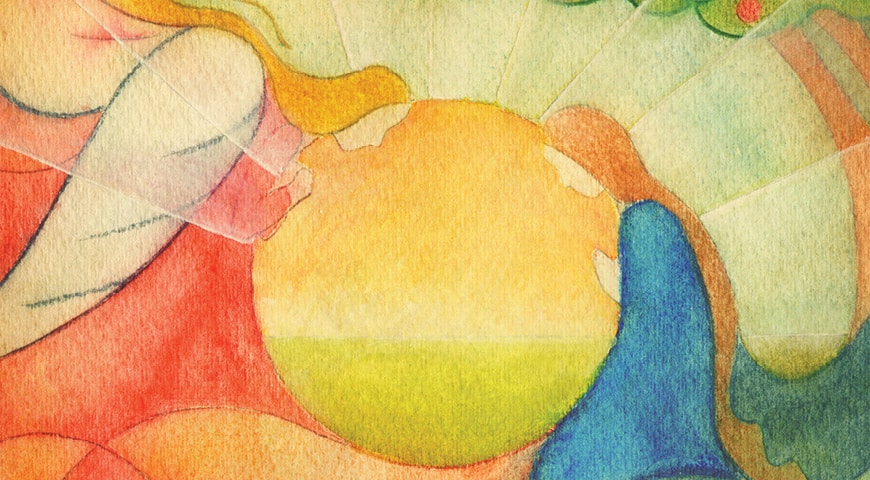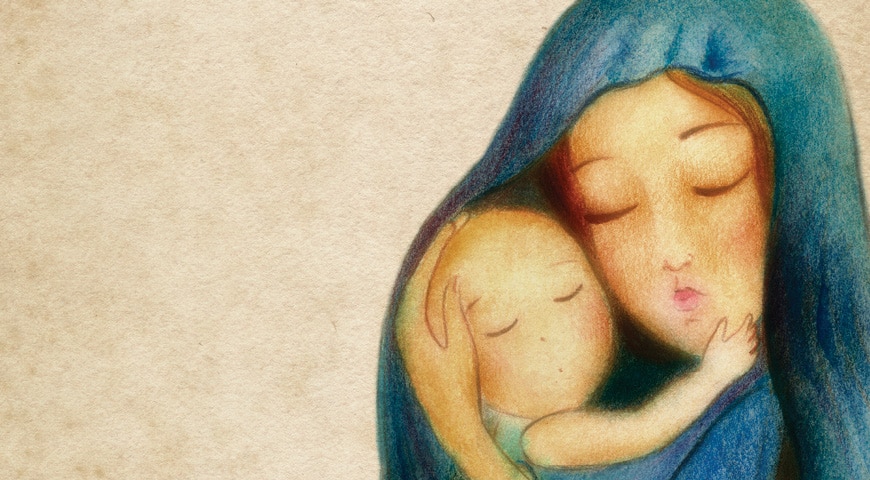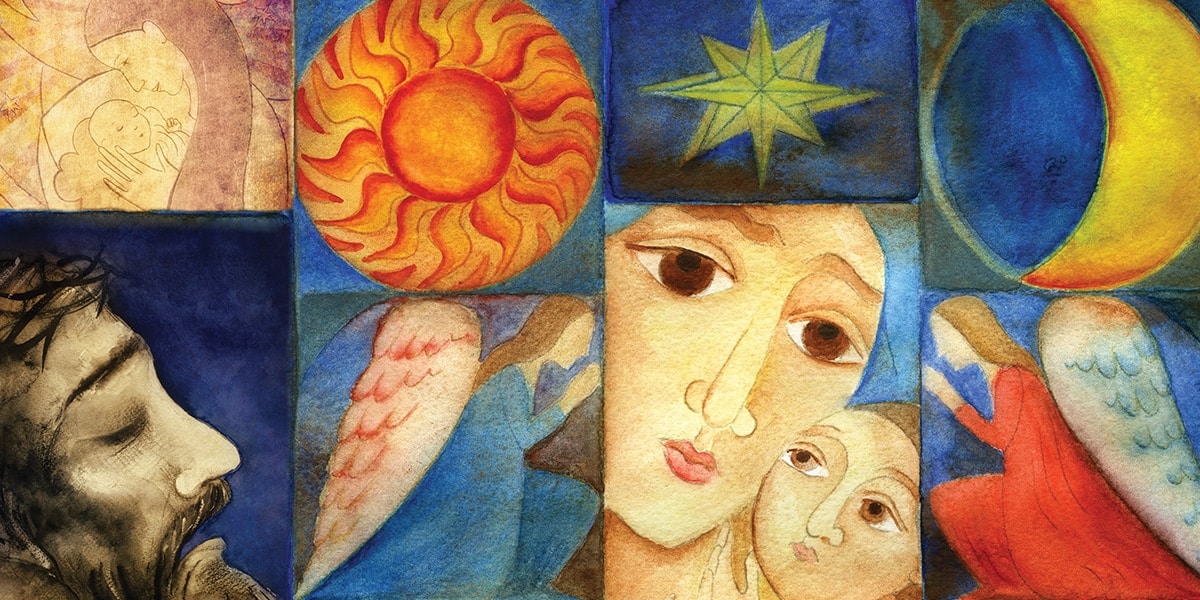As Mary grew older, what would she have thought about her role in the story of our faith tradition? A Franciscan writer imagines just that.
Of all the stories I’ve read in my lifetime, few opening lines move me more than this sentence from the Gospel of Luke: “The angel Gabriel was sent from God to a town of Galilee called Nazareth, to a virgin betrothed to a man named Joseph, of the house of David, and the virgin’s name was Mary” (1:26–27). I know now what’s coming, of course, but there was, once upon a time, a young boy in a New Mexico border town who opened the Douay Rheims version of the New Testament and read those words for the first time.
This is when I began to fall in love with story itself as the vehicle of grace and knowledge. We are not just our minds. We live and move and have our being in and with the world around us. We experience our lives through all of our senses, and all of that experience is conveyed in story, which is more than ideas and beliefs. Story has movement and sound, and portrays how we interact with our environment, with human and living things, from plants to animals to the landscape of our lives in time.
A story follows someone around, asking questions like, Where did he/she come from? Who are they? Where are they going? What is keeping them from getting there? What is going to happen to them? That whole gestalt is what story addresses, using those kinds of questions and then answering them through the same five senses by which we experience life, our own life. And story takes place in time, that mysterious dimension that begins, whether it is stated or not, with “Once upon a time . . .”
The pages that follow are Mary’s story as a human being who brings God to earth, Mary of Nazareth, the human mother of Jesus, who becomes the Queen of Heaven and Earth, the Mediatrix of All Graces.
The meditations come from a Franciscan way of praying that the scholar Ewert Cousins called “the mysticism of the historical event,” which consists of taking a scene from Scripture and putting yourself into the scene, imagining you are one of the characters, and letting the scene open itself up to you. It is not just an intellectual exercise. It is a dimension of prayer in which you are open to grace and to the spiritual energy that derives from that particular scene or event in Scripture.

It is akin to a pilgrimage to a geographical place where an extraordinary spiritual event took place. The pilgrims who make their way there don’t just seek an intellectual experience of the event but pray that the grace of that particular place will be given them to live it out in their lives that day and every subsequent day of their lives. St. Ignatius of Loyola later embraced this Franciscan way of praying, and it became an integral part of his Spiritual Exercises.
These meditations are focused on the last year of Mary’s life when she is living with John, the Beloved Disciple, in Ephesus. (It’s possible she may also have lived for a time with John on Patmos.) It was Jesus himself who gave them to each other as mother and son when he spoke to them from the cross thus: “When Jesus saw his mother and the disciple there whom he loved, he said to his mother, ‘Woman, behold your son.’ Then he said to the disciple, ‘Behold your mother.’ And from that hour the disciple took her into his home” (Jn 19:26‚ 27).
She knew from the moment of the rush of Gabriel’s wings and his lilting “Hail, full of Grace,” that she was only the handmaid, the servant of the most high God, and Gabriel only the messenger of God’s message. But what she could not have known was that she was more than God’s servant; she, mysteriously, was to be a vessel of the living God, and she was afraid. And Gabriel knew she was afraid and said, “Do not be afraid, Mary, for he who will be born of you will be known as the son of God.”
How can this be, she thought, and immediately she knew that God had come to her because she was a woman, and she was pure potential for motherhood, and no one human would be the agent.
And knowing, Gabriel said, “The Holy Spirit will come upon you, and the power of the Most High will overshadow you. Therefore the child to be born will be called holy, the Son of God” (Lk 1:35). Then she, in turn, replied, “May it be done according to your word” (Lk 1:38). And that was it, Gabriel himself open-eyed at her response; he himself, like her, unaware of the depths of the words they were exchanging, aware though of whose words Gabriel had announced to her.
The words’ unfolding would be her pregnancy full of grace and light unimaginable: a child whom she was to name Jesus, a child of her womb, a son whose origins were in eternity, begotten of God, born of a woman who was her very self, a mere girl who was suddenly woman, mother of a boy who was pure mystery though he was somehow in her like any baby and would come from her into the world.
That is how she remembered it, here in Ephesus. She was now as she was then: a girl, a woman, waiting and watching for the angel who would announce the word of her passing into the heaven where her Son ruled at the right hand of the Father. She was not afraid. She needed no Gabriel to reassure her. She’d lived too long in the immensity of the mystery to doubt.

Nor did she wonder who she would be in eternity. She would be who she always was: Mary, the mother of God’s Son. She suspected that would be her role for all eternity: mother, woman, the completion of the love of the mysterious faces of God—Father, Son, Holy Spirit—the mystery moving through the three of them into her, visible in eternity as it is invisible on earth.
She would share these thoughts with John, who would see immediately that they are not her own aged self-absorption but her meditations on God’s mystery, her part in which was only as great or as small as God’s plan, God’s word. And the Word, as John insists, was there in the beginning and became flesh through her only because God chose to reveal the Word by becoming human, by enfleshing the Word in Jesus.
How marvelous such thoughts were! How sustaining when she remembered how Jesus suffered and died—and she was helpless to do anything to save him who was saving her and the whole of the Father’s creation by hiding his divinity in suffering and dying like a mere man. How much was still hidden from her. How much was revealed when Jesus came for her and led her into the mystery of who he and she really are, when the mystery was opened and revealed, when the human Jesus became the eternal word he always was, even as a child in her womb and as a dead man in a tomb.
She smiled at how much she still remembered, the girl who thought and prayed and played in Nazareth. The Little Thinker, her mother called her. Who we are we were, she thought. And when I die, will I just die into my thoughts that will bring me into heaven on the arm of my son?
She did not recognize him at first, though she knew it was he. His eyes were the same, the color of the sea, blue to green depending on the light and season of the year. “Little pools,” she called them when he was a baby. Yet how changed his countenance and body now. What marvels of transformation between dying and rising!
She could only imagine what had transpired between his death on the cross and this extraordinary man standing in the room, the doors locked and they all gathered in prayer, and she wondering how and when he would reappear among them, and would he still be her son? But of course he was, and he called her “our mother.” It was the “our” that was new and sounded prophetic, sounded almost eternal. A given, something that was there from eternity.
The other disciples only looked on, wondering. He had no discernible clothes, though he was covered in an opaque aura, a sort of raiment that allowed his glorified wounds to reveal that skin was still there. His hands hung out from the tunic-like raiment, and his feet, though bare, touched the floor the way they did when he would come in from playing and would remove his sandals, as though the earthen floor were sacred, and he needed to feel it as he walked over to embrace her.
John Quigley, OFM, explains how the Church came to believe that Mary gave birth to both the human and divine natures of Christ.
How she had waited for that embrace! Her whole life from the time Gabriel, God’s messenger, appeared to her, she had lived her life in waiting. She waited in Egypt for God to reveal that she and Joseph and Jesus would be safe to return to their homeland. Even now she waited, doing what she always did in her daily life, a lesson she had learned when she was told of her cousin Elizabeth’s pregnancy. She had made the extraordinary journey to Elizabeth, who was in her sixth month of waiting as she held John the Baptizer within her womb, both she and Elizabeth waiting then to be acted upon by God, both of them wondering what mystery would be revealed in the child they bore as other women did, the very baby within them.
Waiting. Waiting for the mystery to be revealed to them. Waiting and doing what all women did in the waiting: namely, living as they always did, only now for two, the baby and themselves, whose lives would be revealed to them when the child was born. In her and Elizabeth, they already knew, was a boy, whose tiny feet would one day walk upon the earthen floor that their extraordinary lives would transcend when, as men, they would begin the redemption of Israel.
All life, it seemed to her, was shown us in the waiting of a woman’s pregnancy. You lived from day to day, as before, but ever aware that there was a miracle within waiting to reveal itself. The difference for Elizabeth and Mary herself was that they both already knew that their child would be extraordinary in the history of their people. It had nothing to do with them but with God’s working quietly within them.
And yet, it had everything to do with them, for their child would be blood of their blood, flesh of their flesh, so they themselves would be bearing the child in the reverence of prayer, the awareness like unto their own deep prayer. And it was that prayer that made the waiting itself a prayer that their very way of being and doing would be one part of their contribution to the forming of the child within them.
They could not force the time to be shortened; they could not act in some grand way with the gestures reserved for their sons. But both—in their own ways—had prepared their sons by the love with which they surrounded this child-to-be in their waiting for him to be revealed. They waited to see how their love had made a very baby in whose eyes they would see their own love given prayerfully for nine months.
And now in this new rebirth of Jesus, Mary could still see her own love in the eyes that looked back at her as he walked upon the earthen floor, much as he had walked the first time he waddled and stumbled into her arms, a little baby boy becoming.
She had held Jesus in her arms once he’d walked so determined but hesitantly toward her open arms; she had held him lifeless in her lap when he was taken down from the cross; she would now wait for him to embrace her with the love with which she had embraced him all the days of his life.
Even when he left home to embrace the Father’s will that he preach and teach, suffer and die for the people of Israel, she embraced him lovingly in her heart every day as she waited for the next mystery to be revealed. When God works upon us, she thought, then the real working of our lives is in the waiting, waiting to receive what is given us when we wait upon the Lord in all we are and all we have.
What new waiting will now follow upon this new embrace of him who approaches her Godlike in his bearing and in his walk but still walking like an ordinary man upon the earthen floor upon which he was born.








